Content
- 1 Proper care and cultivation of cauliflower outdoors
- 1.1 What is cauliflower
- 1.2 Origin story
- 1.3 Beneficial features
- 1.4 How to grow cauliflower from seeds on the site
- 1.5 Planting seedlings in open ground - scheme and agricultural technology
- 1.6 Care and Growing Secrets
- 1.7 Susceptibility to disease and pests
- 1.8 Harvesting and storage - step by step instructions
Proper care and cultivation of cauliflower outdoors
Healthy eating means eating healthy foods rich in vitamins and minerals. These include cauliflower, so many gardeners practice growing vegetables in their backyards in the open field. With proper care, this is easy.
Subject to the correct planting scheme, you can plant cauliflower in the country and in the Moscow region. It is necessary to sow seeds for seedlings at home, following the step-by-step instructions for care and feeding to guarantee seedlings.
What is cauliflower
The general understanding of cabbage does not apply to cauliflower varieties, although it also belongs to the cruciferous family. The plant has fibrous roots located close to the soil surface. The heads are formed in round and semicircular shapes. The edible part is represented by dense flowering clusters, the length of which varies. from 2 to 15 cm.
Cauliflower is an annual crop with a growing season 90-120 days after emergence. Plant loves light, therefore, you need to plant seedlings in well-lit areas.
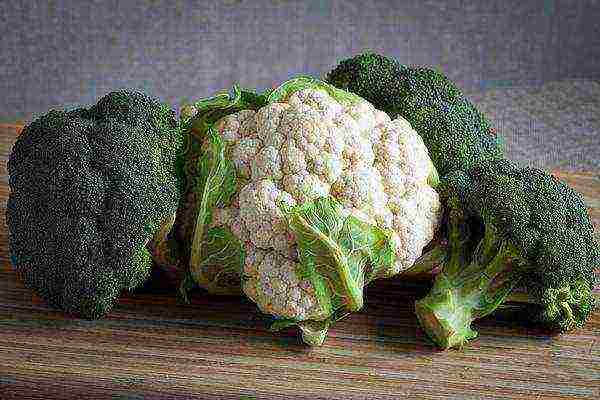
To taste, the inflorescence is soft with shades of milk, it is not for nothing that it is called vegetable cottage cheese. When preparing dishes with the help of spices, it is possible to give the vegetable unusual notes that are not characteristic of cabbage.
Origin story
It is believed that cauliflower was developed in the Mediterranean. It was previously referred to as Syrian. In those days, the vegetable was late ripening, had a bitter taste and a creamy green inflorescence. The culture was first described by the Arab botanist Ib el-Beitar.
The culture came to Russia only 2 centuries ago, but it was possible to grow a heat-loving plant only in the southern regions. After the famous scientist Bolotov deduced northern version of cabbage, it became possible to cultivate the vegetable in the northern part of the country.
Beneficial features
Cabbage contains many valuable vitamins and minerals that have a beneficial effect on the human body:
- calcium improves the condition of hair, nail plates and teeth;
- vitamin C helps to strengthen the immune system;
- potassium has a positive effect on the work of the cardiovascular system;
- magnesium and iron improve blood flow in tissues;
- B vitamins activate brain activity.
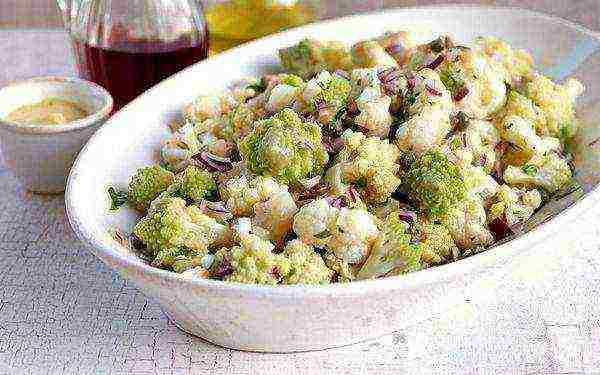
Many diet tables include cauliflower dishes. This is due to the ability restoration of metabolic processes, setting the work of the digestive system. The active ingredients cleanse the body of toxins and other toxic substances, and the rich vitamin composition (A, D, E, K, H, PP, etc.) strengthens the protective function.
How to grow cauliflower from seeds on the site
Inflorescences are grown by seed and seedling methods... Of course, you can purchase ready-made seedlings and plant them in the garden.However, it is impossible to be sure of the quality of the seed material used and the conditions for the germination of seedlings. Therefore, it is rational to grow seedlings on your own.
Sowing time at home
Seeds are sown in 40-50 days before planting seedlings on an open bed, this period falls on approximately end of February.
The early varieties are sown first, after which, after 2 weeks, mid-season cabbage, and only a month later they move on to planting grains of late varieties.
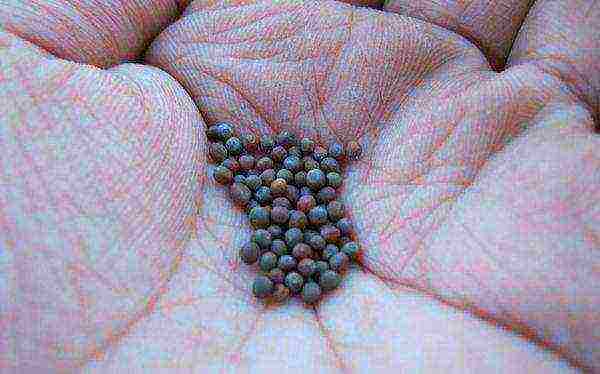
Sowing material is first sorted, then prepared before planting. Processing is done using a thermos with water, the temperature of which is 50 degrees. After 15 minutes of steaming, the seeds are immersed in cold water for a minute, after which they spend 12 hours in a solution of microelements that stimulate growth.
After the shoots appear on the surface of the soil, the temperature drops to 6-8 degrees. Days after 6-7 degrees, you need to increase to a daytime rate of 15-18 and 6-8 at night.
Seedling care
Caring for seedlings does not contain secrets or cardinal features and consists in moderate watering (by spraying), loosening the soil, observing the temperature regime.
After the formation of 2-3 leaves of the plant at the shoot, you need spray with boric acid solution (2 grams per 1 liter of water). After 1-2 weeks, the treatment is repeated, but with a solution ammonium molybdate (5 grams per bucket of water).

Picking
Usually a pick of cauliflower seedlings not carried out due to an underdeveloped root system... But if the seeds were sown in a common box, then when sowing the seeds should be placed at a great distance, and the depth of the soil in the container should be at least 15 cm. Then the seedling can be removed from the box along with the soil.
It is recommended to plant seedlings in separate containers at the age of 2 weeks... Before the seedlings finally take root in a new place, the temperature in the room, at home or where the seedlings are stored should be within 19-21 degrees.
Planting seedlings in open ground - scheme and agricultural technology
Early maturing varieties are planted in open ground late April-mid-May... A week before the start of planting, the seedlings are fed with superphosphate (3 g), potassium chloride (3 g), diluted in a liter of water. This will increase the cold hardiness of the shoots. You also need to harden, accustoming plants to a new habitat.
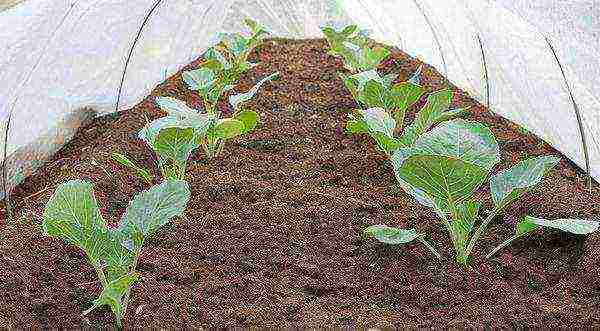
The soil prepared in the fall is dug up before planting. A mixture of compost (humus), wood ash, superphosphate, urea (1 bucket / 2 cups / 2 tbsp. L. / 1 h. L.) Is added to each hole. All components are mixed with fertile soil.
The seedlings are buried in the soil to the first sheets, after which it is well compacted with earth. Watering is carried out immediately after planting. Spring weather often surprises with night frosts. To protect the garden from them, you should cover it with agrofibre or film.
Care and Growing Secrets
Cauliflower grows well in warm climates. She tolerates the conditions of the middle lane only thanks to anxious care, therefore the quality and quantity of the crop depends only on the efforts made.
Proper watering
Moisture is necessary for the normal vegetation of the plant, therefore watering is carried out regularly with a frequency 1-2 times a week.
Water consumption rate for 1m2 beds with young shoots is 6-8 l... Over time, the indicator increases to 9-11 liters per 1 m2.
Irrigation frequency increases in hot weather up to 3-4 times a week, but in any case, it is worth focusing on the degree of soil moisture, because waterlogging is just as dangerous for a plant as drying out.
Features of loosening and weeding
Weed grass thickens the beds, provoking the development of various diseases. In addition, it shades the crop, resulting in dark spots on the inflorescences.
Weeding should be combined with loosening the soil, it is also recommended mulch the bed with peat or dry grass... This will prevent the soil from drying out and the rapid germination of weeds.
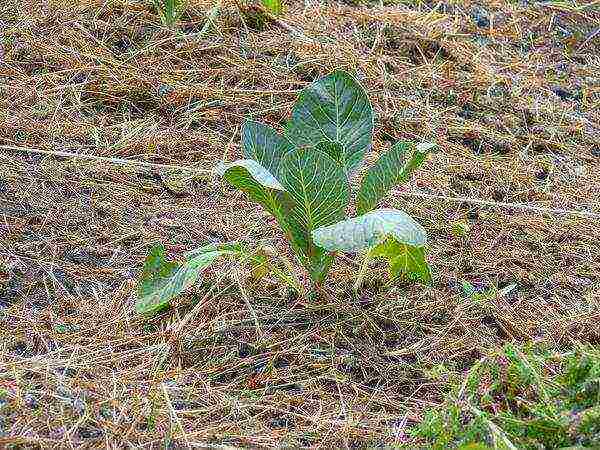
Top dressing
During the growing season, cabbage must be fed 3-4 times... The first portion is introduced 3 weeks after transplanting the seedlings. The best food for the culture is a mullein solution (a liter of liquid composition is dissolved in a bucket of water). Under each bush is poured at least 500 ml of fertilizer.
The second feeding is introduced after 10 days. It is recommended to add 1 tablespoon of Kristalin to the mullein solution. Use 1 liter of blank for each plant.
After another 10-14 days, mineral fertilizers are introduced (for 10 liters of water 2 tbsp. L. Nitrofoski, the consumption rate per 1 m2 is 6-8 liters).
Treatment
The advantage of cauliflower agricultural technology is the possibility of using biological agents without the use of pesticides. Dusting from wood ash or tobaccospraying with infusions from onion skins or burdocks.
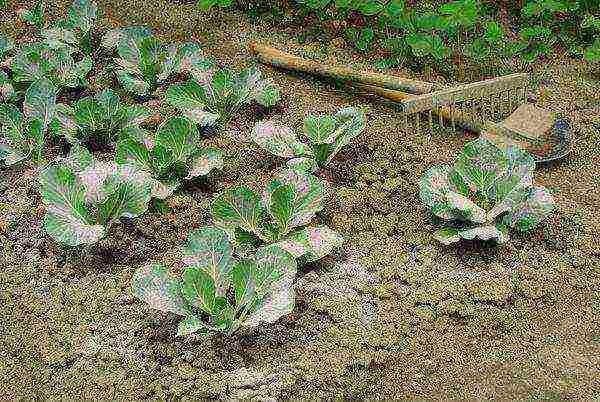
Susceptibility to disease and pests
Cauliflower is susceptible to various diseases and pest attacks, so during the growing period, you need to regularly inspect the plants in order to identify the problem at an early stage.
The development of harmful microorganisms often begins as a result irrigation irregularities or because of the presence of the pathogen in the seed.
The following diseases are considered the most dangerous:
- mucous bacteriosis - the first signs appear on the head in the form of watery spots; for localization, you need to cut off the affected area, capturing a little healthy tissue;
- blackleg - blackening and softening of the root collar and base of the stem, before sowing, the soil and seeds are disinfected, if lesions are detected, the plant is removed from the garden;
- mosaic - spots of different shapes and colors appear on the leaves, diseased bushes cannot be treated, if found, they must be destroyed;
- keel - a fungal disease that affects the root system of a plant, manifests itself in the form of growths on the roots, when detected, the bush is removed, protection is created by preventive measures;
- pernosporosis - the fungus appears on the leaves in the form of yellow spots with a white coating, the treatment consists in spraying the beds with a solution of Bordeaux liquid (1%) or polycarbocin (0.4%).
- Cauliflower bacteriosis
- Defeat leaves with mosaics
Harmful insects can also reduce the yield or destroy the garden bed:
- cruciferous fleas;
- cabbage fly;
- aphid;
- stem hidden proboscis;
- butterflies.
If pests or signs of the presence of larvae are found, it is necessary to process the beds using the following means:
- Entobacterin-3;
- Actellik;
- Aktara;
- Iskra M et al.
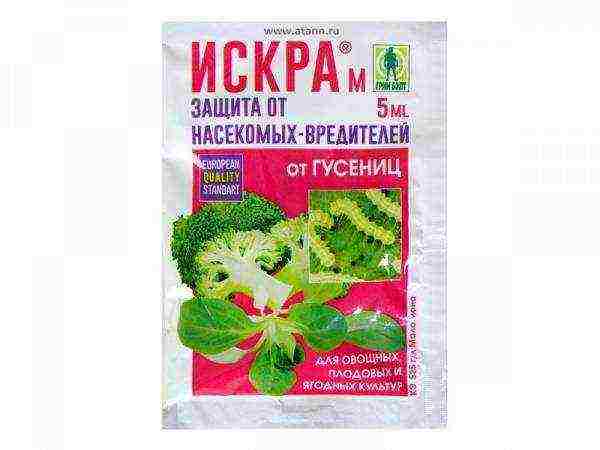
Chemicals and biologicals are used upon detection of signs of a parasite infestation.
But it is more effective to carry out prophylaxis, which prevents the defeat of the culture by pests.
Activities include:
- thorough cleaning of plant waste in the autumn;
- removal of damaged shoots from the beds to localize the problem;
- disinfection of soil and seeds;
- spraying with biological solutions;
- pollination of beds with wood ash.
Harvesting and storage - step by step instructions
The ripening time of the inflorescences indicated on the seed packaging is approximate, so you need to navigate outwardly... If the crop is harvested earlier or later, then the heads will quickly deteriorate or germinate.
The maturity of a vegetable depends primarily on the growing conditions, in particular on the temperature regime. Collection begins in the second half of July mid-season varieties.Heads are cut from the end of August and throughout September late maturing cabbage, which has a long shelf life (from 5 months and more).
.
- The inflorescences must be cut at the base of the stem
- Storage is carried out in a damp room in plastic boxes
The inflorescences are cut with 2-3 leaves at the base of the stem. The vegetable does not lose its properties for 40-50 days. When determining maturity, the following characteristics are taken into account:
- head diameter reaches 10-12 cm;
- the inflorescence is light green or creamy;
- dense structure.
To increase the shelf life, the cauliflower is removed from the garden along with the root system. This method is suitable for slightly unripe vegetables that reach maturity in trays of soil.
Harvest storage rules:
- heads folded into a cardboard or plastic container are installed indoors with a high level of humidity up to 95% and a temperature of 0-2 degrees;
- inflorescences cleared of excess leaves can be stored in the refrigerator, having previously wrapped them with cling film;
- the fragments, washed and separated into inflorescences, remain in the freezer for a long time.
It is also allowed to store cabbage in the basement, hanging it upside down on wooden sticks.
The cultivation technique of cauliflower does not fundamentally differ from the cultivation of other varieties. Therefore, you can safely replenish the range of crops in your own garden. If you take care of it according to the instructions, you can get an excellent harvest of the vegetable.


